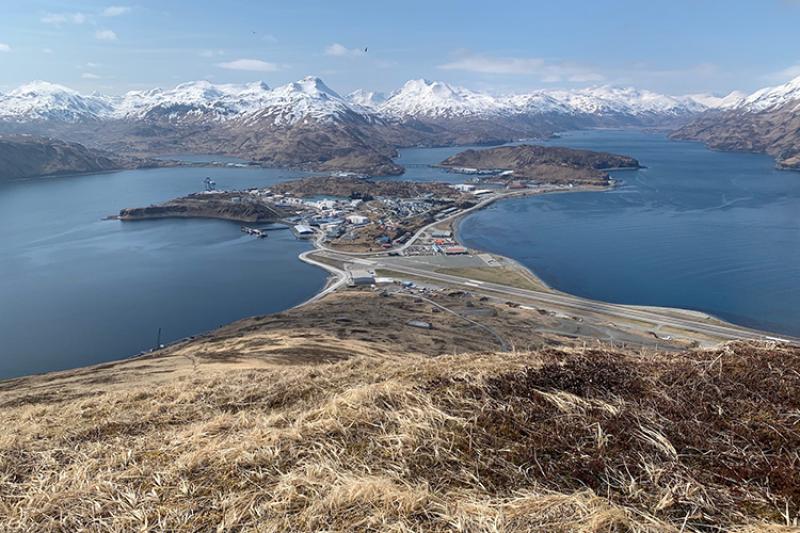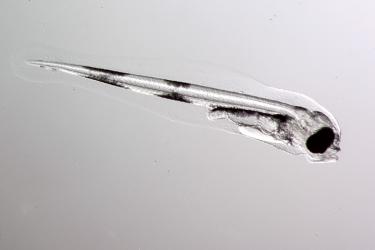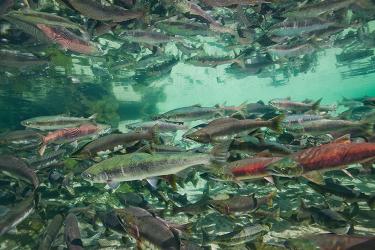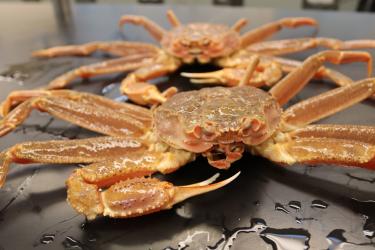Seafood is a vitally important source of protein. Worldwide, more than 3 billion people rely on seafood as a significant part of their diets.
The amount that we can sustainably fish and farm is based on historical catches and trends that have been monitored for decades. We need to understand their breeding cycles and growth rates, along with cyclical patterns of ocean currents and climate—and the ecosystems they live in. This allows us to build models that inform sustainable management strategies for harvesting seafood. However, climate change continues to disrupt long-standing expectations, strategies, and the communities that depend on them.
Scientists at the NOAA Fisheries Alaska Fisheries Science Center are collaborating with communities, managers, and other government and academic scientists in the Bering Sea region. They authored a new paper that develops climate-informed management scenarios for fisheries in the eastern Bering Sea.
“Several years ago, we recognized that climate change was going to affect our fisheries in Alaska. So, in 2015, we started a new initiative, the Alaska Climate Integrated Modeling Project, or ACLIM, with the goal of creating climate informed models to help us adapt to a warming planet,” remarks Anne Hollowed, lead author and retired center scientist.
ACLIM is a collaboration among more than 50 interdisciplinary experts that projects and evaluates climate impacts and effective responses for social and ecological systems in and around the Bering Sea. It is also part of NOAA’s Climate, Ecosystems, and Fisheries Initiative (CEFI) to build decision support systems for climate informed decision making in each region.
Kristin Holsman, co-author with the center and co-lead investigator on ACLIM, adds, “The climate change shifts and extreme events that have occurred over the past decade in the North Pacific and Bering Sea really underscore the need for climate innovation in fishery management. ACLIM lets us meaningfully connect cutting-edge science tools and information for fishing communities and resource managers to help prepare for and respond to climate change. The key in this is incorporating social and economic input in addition to biological and oceanographic information.”
The climate-related events that Holsman refers to are the 2015–2016 and 2018–2019 marine heat waves. They caused wide-scale declines in marine species such as snow crabs.
University of Washington scientist and co-author Andre Punt states, “The interdisciplinary nature of ACLIM is what makes it so valuable. Along with NOAA, we have representatives participating from our university, the North Pacific Fisheries Management Council, Native Alaskan communities, international organizations, among others—all dedicated to solving these important issues related to climate change.”
Developing Climate-Informed Scenarios Through Workshops
ACLIM is made up of oceanographers, ecosystem modelers, economists, social scientists, and resource managers, and it has extended to a broader community through a series of workshops. It offers a unique approach to fisheries management by incorporating scientific models along with social-economic data to pursue a truly holistic approach. Humans, after all, are a fixture on this planet; our social and economic needs should be incorporated into resource management.
The workshops look at past shifts in ocean conditions or extreme events that caused major changes in ecosystems. Projecting further, participants evaluate alternative futures and adaptation strategies given our new reality of climate change induced events.
For example, after the 2018–2019 marine heat wave, we saw rapid declines of some crab stocks in the Bering Sea. There were also abrupt shifts in the distribution of some groundfish species. Fishing operations were impacted, with many shifting to previously non-fished locations. In some cases, this raised interactions with non-targeted species and other users. Small-scale fisheries and large industrial fleets were affected differently. Subsistence users reported changes in fish condition and harvesting less-desirable species. Many other impacts rippled across the fishing industry, local economies, and subsistence communities.
Participants noted that the current regulatory system was not flexible enough to adjust to extreme events like the marine heat wave. Many other approaches were explored, such as investing in climate-ready infrastructure, reducing the industry’s climate footprint, and pivoting to other fisheries or markets. This is just one of many case studies presented in the new publication.
The paper also recognized that additional effort should be made to meaningfully engage with Indigenous peoples in developing climate scenarios, adaptations, and to better understand climate impacts. From co-author Sarah Wise, “We have been working really hard to build bridges between ACLIM and coastal communities in western Alaska, and we continue to invest time and resources to expand collaborations with Indigenous partners. This is an integral part in the next phase of ACLIM.”
Regional Models Can Inform Global Approaches
“Ultimately, it’s about bringing as many people to the table as possible, hearing diverse voices, and collectively coming up with innovative ideas to support effective management and adaptation responses to change in the Eastern Bering Sea. With this approach, our climate-informed science and advice can help fisheries, economies, and communities advance resilience in the face of climate change,” says Holsman.
Feedback from commercial fishers was clear: effective business planning depends on having a reasonable expectation of future income. They recognized that the ACLIM modeling suite could help the North Pacific Fisheries Management Council transition to climate-informed ecosystem based fisheries management. It would allow them to expand the models to include a broader range of human activities.
Finally, there’s hope that this regional work in Alaska could benefit people well beyond the eastern Bering Sea. Hollowed shares, “Our goal was to explore what types of transformative innovations work best for regional fisheries and communities. But, we also hope to communicate our findings with others to advance the global discussion around carbon mitigation approaches that provide the most opportunities for future sustainable fisheries.”
In the next phase of ACLIM’s work, we will share and explore additional social and economic approaches. The collaborative will continue striving toward resilience and increased food security on local, regional, and national scales.
To this end, this summer the North Pacific Fisheries Management Council will host a climate scenarios workshop in Kodiak. ACLIM also plans to use future workshops to help develop and refine the Alaska Climate Change Adaptation Planning Tool Dashboard for sharing and exchanging information.
Funding for this work was provided through the NOAA Climate and Fisheries Adaptation Program.







